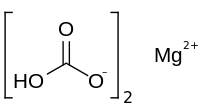Magnesium bicarbonate
 | |
| Names | |
|---|---|
| IUPAC name
Magnesium hydrogen carbonate | |
| Other names
Magnesium bicarbonate | |
| Identifiers | |
| ChemSpider | 92335 |
| Jmol-3D images | Image |
| PubChem | 102204 |
| |
| Properties | |
| Mg(HCO3)2 | |
| Molar mass | 146.34 g/mol |
| Related compounds | |
| Other cations |
Calcium bicarbonate |
| Except where noted otherwise, data is given for materials in their standard state (at 25 °C (77 °F), 100 kPa) | |
| | |
| Infobox references | |
Magnesium bicarbonate or magnesium hydrogen carbonate, Mg(HCO3)2, is the bicarbonate salt of magnesium. It can be formed through the reaction of dilute solutions of carbonic acid (such as seltzer water) and magnesium hydroxide (milk of magnesia).
Magnesium bicarbonate exists only in aqueous solution. To produce it, a suspension of magnesium hydroxide is treated with pressurized carbon dioxide, producing a solution of magnesium bicarbonate:[1]
- Mg(OH)2 + 2 CO2 → Mg(HCO3)2
Drying the resulting solution causes the magnesium bicarbonate to decompose, yielding magnesium carbonate, carbon dioxide, and water:
- Mg2+ + 2 HCO3− → MgCO3 + CO2 + H2O
References
- ↑ Margarete Seeger; Walter Otto; Wilhelm Flick; Friedrich Bickelhaupt; Otto S. Akkerman (2005), "Magnesium Compounds", Ullmann's Encyclopedia of Industrial Chemistry, Weinheim: Wiley-VCH, doi:10.1002/14356007.a15_595.pub2
| ||||||